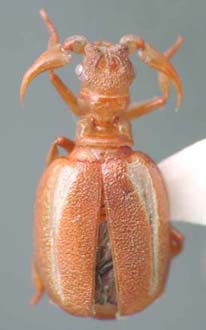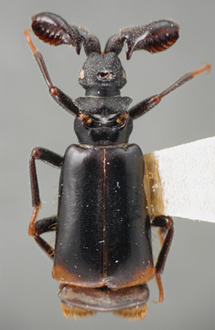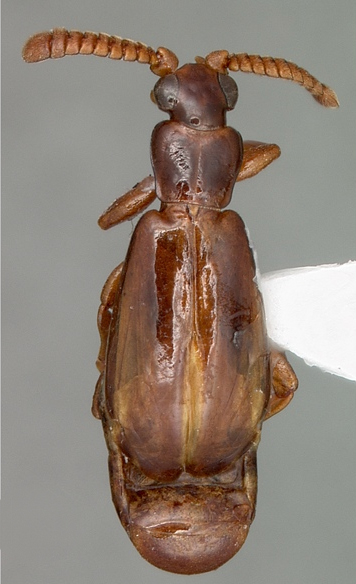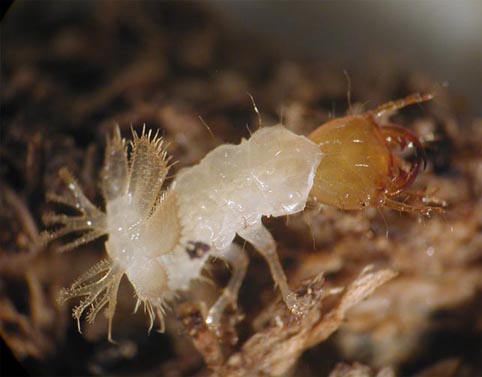My core research interests are systematics, phylogenetics, evolution, and biogeography, particularly of the invertebrates and especially arthropods. I began my systematic research on marine isopod crustaceans and I am still extremely interested in marine invertebrates. However, my research focus has shifted to the terrestrial realm and my current research projects are focused on beetles, particularly those classified in the carabid beetle subfamily Paussinae. This group contains 750 described species that are distributed in all tropical regions of the world. These beetles are commonly known as bombardiers, due to their ability to explosively discharge defensive chemicals at temperatures up to 100°C! Most species are obligate symbionts with ants - a lifestyle that has led to an astounding array of morphological diversity within this group, especially within the tribe Paussini.
 |
 |
 |
My work includes taxonomic revisions, descriptions of larvae, molecular-based and morphology-based phylogenetic inference, and biogeographic analyses.
Although I foresee including other taxa in my research program, paussines will be an ongoing component of my life's work. Their explosive defensive chemistry, myrmecophilous lifestyle, co-evolution with ants, bizarre morphology, and pan-tropical distribution are all qualities that make them fascinating subjects of study. Throughout my career, I envision collaborating with scientists in different disciplines to bring a multidisciplinary approach toward understanding the patterns and processes that have shaped their evolutionary history.
Read more about paussine beetles here.
Revision of Eohomopterus
In collaboration with Dr. Peter Nagel (Basel, Switzerland), I am revising the Neotropical paussine genus Eohomopterus. Prior to our work, four species of this genus were known only from their respective holotype specimens. Our revision includes descriptions of seven new species, two known only from Dominican amber fossils. This work includes a molecular-based phylogeny of paussine genera that will test the sister group relationship between Eohomopterus and the African genus Carabidomemnus.
 |
 |
Revision of Malagasy Paussines
I am revising the paussine fauna of Madagascar. The level of endemism is extraordinarily high, all of the 50 described species from Madagascar live only in the Malagasy region. Many specimens of undescribed species have been collected as part of an ongoing research effort by members of the Department of Entomology here at the California Academy of Sciences (CAS). My work will make information on approximately 65 species readily available to researchers worldwide on the Internet. This will facilitate the potential use of these organisms in other types of scientific studies (e.g. ecological monitoring, etc.). This research will also delimit areas of endemism within Madagascar - information that can be used to guide conservation planning. I am also infering the phylogeny of the group with molecular sequence data. Resulting trees will reveal patterns of relationship within the Malagasy fauna and provide a framework to assess morphological characters and determine which characters are evolutionarily informative at the species-group level. This knowledge can then be applied to species in broader biogeographic areas (e.g., Africa, SE Asia) where it is relatively difficult to collect a representative subset of the fauna for molecular studies. |
 |
Conservation
Systematists are in a race against time. It is our job to document earth's biodiversity, and understand it well enough to help make informed decisions as to how to best protect it. Nowhere is the need for action more evident than it is in Madagascar. Madagascar is widely recognized as one of the world's hottest hotspots, with a megadiverse and unique biota. It is one of the world's greatest conservation priorities. The more we learn about the flora and fauna of the region, the better prepared we will be to protect what remains. The most important impact of my postdoctoral research will be to contribute to the efforts of the California Academy of Sciences to increase our knowledge of arthropod diversity on Madagascar. Knowledge of terrestrial invertebrate diversity will ultimately contribute to the ability to make well-informed conservation decisions in a region threatened with unprecedented rates of native habitat destruction.
Larval Morphology
In collaboration with Dr. Andrea Di Giulio (Rome, Italy), I have described three paussine larvae (Arthropterus sp., Goniotropis kuntzeni, Mystropomus subcordatus) and we are presently working on our fourth (Eustra sp.). We have also published a key to paussine genera based on larval morphology which is electronially available here. All known Paussinae species share an unusual and unique larval trait: the ninth abdominal segment is enlarged and fused with the tergum of the eighth segment; this fusion displaces the urogomphi and the tenth segment into a vertical plane, or terminal disk. Observations of larval behavior have shown that some species can close their terminal disk like a fly trap and they use it to capture insect prey. View a specatcular movie of their ambush feeding stratedy here. Learn more about one such larva here.

First instar larva of Goniotropis kuntzeni.
Phylogeny based on Molecular Sequence Data
One of the obstacles in producing a classification of the Paussini is the difficulty in distinguishing those characters that are apomorphies reflecting shared evolutionary history, from those that have evolved independently in separate lineages as adaptations to a similar lifestyle (convergences). Paussine species exhibit varying degrees of association with ants that has led to an astounding array of morphological diversity within this group. Molecular sequence data are proving to be particularly useful for resolving the phylogenetic history of this group, which has many convergent characteristics. I am developing a multi-gene data set, with a taxon sampling scheme designed to infer the deep relationships within this group. These genes include a mitochondrial protein-coding gene (COI), two nuclear protein-coding genes (CAD and wingless), and two nuclear ribosomal genes (18S and 28S). This project will provide a phylogenetic framework for investigating of the evolution of myrmecophily and the characters and behaviors associated with this lifestyle. The possibility that the paussines and their host ants have undergone some degree of co-evolution, or even potentially co-speciation, underscores the importance of knowing the phylogenetic history. In order to understand the relationships between paussines and their host ants, and to determine the nature of their interactions, extensive behavioral analyses will need to be conducted. Phylogenetic analyses will identify specific taxa that would be most important to target for these studies.

Evolution of Explosive Defensive Chemistry
Bombardier beetles explosively discharge defensive chemicals at temperatures between 55°C and 100°C, a defensive strategy that effectively deters both invertebrate and vertebrate predators. They have a pair of complex, two-chambered defensive glands, consisting of a reservoir chamber and a heavily sclerotized reaction chamber. Hydroquinones and hydrogen peroxide in the reservoir chamber mix with catalases and peroxidases in the reaction chamber creating defensive benzoquinones in an exothermic reaction just before they are expelled from the body in an audible explosion. This intricate defensive mechanism is broadly acknowledged as one of the most complex and sophisticated biological designs known in the animal kingdom.
Did bombardier beetles evolve more than once? This question has been the subject of a heated debate that has been voiced in the literature for over 150 years. Bombardier beetles are classified in two subfamilies, Brachininae and Paussinae, within the large beetle family Carabidae (40,000 described species). Most carabids store their defensive chemicals in single-chambered glands. Although two-chambered defensive glands and explosive defensive chemistry are unique to the bombardiers, many systematists think that the bombardier defensive mechanism in the Paussines and the Brachinines is a product of convergent evolution. Controversies arise over the phylogenetic affiliation of paussines due to their unique combination of characters, some of which have been traditionally thought of as plesiomorphic (primitive) within the Carabidae and some that are potentially apomorphic (advanced) and shared with the derived brachinines. Along with my collaborators Dr. David Maddison and Tana Ellis, I am testing these two competing hypotheses with molecular sequence data.
Presentation of Research
Moore, W. 2008. Molecules in 21st Century Natural History Museums. San Francisco Bay Area Biosystematists (BABS). Moss Landing, CA.
Moore, W. 2007. Private Beetle Collection Moves to a Public Museum: Associated Issues and a Plan for Curation. Entomological Collections Network. San Diego, CA.
Moore, W. 2007. Evolution of Adult and Larval Structure, DNA Sequences, Chemicals and Behavior of Paussine Beetles (Coleoptera: Carabidae: Paussinae). The Department of Entomology, Seminar Series. The Natural History Museum, London, England.
Di Giulio, A.* and W. Moore. 2007. The First Known Larva of the Australian tribe Mystropomini (Coleoptera: Carabidae: Paussinae): Morphology and Phylogenetic Implications within the Subfamily. Immature Beetles Meeting. Charles University. Prague, Czech Republic.
* presented by Dr. Andrea Di Giulio.
Moore, W. 2007. Evolution of Adult and Larval Structure, DNA Sequences, Chemicals and Behavior of Paussine Beetles (Coleoptera: Carabidae: Paussinae). Pacfific Coast Entomological Society. UC Berkeley, CA.
Moore, W. 2007. Evolution of Adult and Larval Structure, DNA Sequences, Chemicals and Behavior of Paussine Beetles (Coleoptera: Carabidae: Paussinae). The Department of Entomology, Seminar Series. Smithsonian Institution, Washington, D.C.
Moore, W. 2007. Molecular Phylogenetics, Divergence Time Estimation, and Biogeography of the Flanged Bombardier Beetles (Coleoptera: Carabidae: Paussinae). Department of Biology, Seminar Series. University "Roma Tre." Rome, Italy.
Moore, W. 2006. Molecular Phylogeny, Systematics and Natural History of the Flanged Bombardier Beetles. California Department of Food and Agriculture. Plant Pest Diagnostics Branch. Sacramento, CA.
Moore, W. 2006. Molecular Phylogenetics of the Flanged Bombardier Beetles (Coleoptera: Carabidae: Paussinae). Festschrift for Dr. George E. Ball. Carnegie Museum of Natural History. Pittsburgh, PA.
Moore, W. 2005. Molecular Investigations into the Evolution of Explosive Defensive Chemistry in Bombardier Beetles. BIO5 Graduate Research Symposium. University of Arizona. Tucson, AZ.
Moore, W. 2005. Phylogeny and Natural History of the Paussinae, an Enigmatic Group of Bombardier Beetles. Entomological Society of America. Monterey, CA.
Moore, W. 2005. Bombardier Beetle Systematics. University of Arizona. Life Sciences Recruitment Poster Session. Tucson, AZ.
Moore, W., A. Mercado, K. Franklin, M. Tarre and T. Markow. 2005. Insect Diversity in Sonora Mexico. Expanding the Ark: The Emerging Science and Practice of Invertebrate Conservation. University of Arizona. Life Sciences Recruitment Poster Session. Tucson, AZ.
Moore, W., A. Mercado, K. Franklin*, M. Tarre and T. Markow. 2004. Insect Diversity in Sonora Mexico. Expanding the Ark: The Emerging Science and Practice of Invertebrate Conservation. American Museum of Natural History. New York, NY.
* presented by Kim Franklin
Moore, W., D.R. Maddison, M.D. Baker, T.M. Ellis, K.A. Ober. 2003. How Many Times have Adephagan Beetles Invaded the Water?: Monophyly of Adephagan Beetles as Indicated by Three Nuclear Genes.” Evolution. Chico, CA.
Markow, T., W. Moore, S. Castrezana, R. Brusca and C. Gibson. 2003. The Sonoran Insect Biodiversity Project. Poster Hexapodium, Center for Insect Science, University of Arizona. Tucson, AZ.
Moore, W, T. Ellis, W. Ho, and A. Rogers. 2002. Seasonal Fluctuation of Beetle Biodiversity in the Sonoran Desert. Thirteenth Annual Undergraduate Biology Research Conference. Undergraduate Biology Research Program, University of Arizona. Tucson, AZ.
Moore, W. 2001. Phylogeny and Natural History of the Carabid Subfamily Paussinae. Departmental seminar. Department of Biology, Chico State University. Chico, CA.
Moore, W. and R.C. Brusca. 1998. Discovery of a Sibling Species Cluster in the Formerly Monotypic Isopod Genus Colopisthus: an Example of Phylogenetic Biogeography. Fourth International Crustacean Congress. Amsterdam, The Netherlands.
Moore, W. 1996. Departmental seminar. Zoologisk Museum, University of Copenhagen. Copenhagen, Denmark.
Moore, W. and R.C. Brusca. 1996. Historical Biogeography of Anthuridean Isopods of the Central Tropical Pacific. 8th International Coral Reef Symposium. Panama City, Panama.
Moore, W. and R.C. Brusca. 1995. Biogeography of the Isopod Crustacea of Bora Bora, Society Islands (French Polynesia). The Crustacean Society. Harbor Branch Oceanographic Institution, Florida.